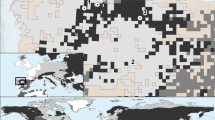Abstract
Sculpin and stonefly predators fed selectively on the larvae of the chironomids Paratendipes over Cricotopus in laboratory stream microcosms. In these experiments, Cricotopus were usually tube-dwelling, whereas Paratendipes were usually free-living. Paratendipes were also bright red, which may have influenced selectivity by visual feeding sculpin, but tactile feeding stoneflies were most likely influenced only by the difference in tube-dwelling behavior of the two prey types. Both chironomids were abundant in the field, but exhibited discrete microhabitat distributions. Field collected sculpin ate mostly Cricotopus, probably because Cricotopus occurred in a more accessible microhabitat.
Similar content being viewed by others
References
Allan, J. D., 1982. Feeding habits and prey consumption of three septipalpian stoneflies (Plecoptera) in a mountain stream. Ecology 63: 26–34.
Brocksen, R. W., G. E. Davis & C. E. Warren, 1968. Competition, food consumption, and the production of sculpins and trout in laboratory stream communities. J. Wildl. Mgmt. 32: 51–75.
Craig, P. C. & J. Wells, 1976. Life history notes for a population of slimy sculpin (Cottus cognatus) in an Alaskan arctic stream. J. Fish. Res. Bd. Can. 33: 1639–1642.
Crowder, L. B. & W. E. Cooper, 1982. Habitat structural complexity and the interaction between bluegills and their prey. Ecology 63: 1802–1813.
Cuker, B. E., 1981. Control of epilithic community structure in an arctic lake by vertebrate predation and invertebrate grazing. Ph.D. thesis, N.C. St. Univ., Raleigh.
Davis, G. E. & C. E. Warren, 1965. Trophic relations of a sculpin in laboratory stream communities. J. Wildl. Mgmt. 29: 846–871.
Devonport, B. F. & M. J. Winterbourne, 1976. The feeding relationships of two invertebrate predators in a New Zealand river. Freshwat. Biol. 6: 167- 176.
Dodson, S. I., 1975. Predation rates of zooplankton in arctic ponds. Limnol. Oceanogr. 20: 426–433.
Fuller, R. L. & K. W. Stewart, 1979. Stonefly (Plecoptera) food habits and prey preference in the Dolores River, Colorado. Am. Midl. Nat. 101: 170–181.
Gilinsky, E., 1984. The role offish predation and spatial heterogeneity in determining benthic community structure. Ecology 65: 455–468.
Herhsey, A. E., 1985. Experimental effects of predatory sculpin on the chironomid communities of two arctic littoral zone habitats. Ecology 66 (4) (in press).
Hildrew, A. G. & C. R. Townsend, 1976. The distribution of two predators and their prey in an iron rich stream. J. An. Ecol. 45: 41–57.
Otto, C. & P. Sjostrom, 1983. Cerci as antipredatory attributes in stonefly nymphs. Oikos 41: 200–204.
Peckarsky, B. L., 1980. Predatory-prey interactions between stoneflies and mayflies. Behavioral observations. Ecology 61: 932–943.
Pidgeon, R. W. J., 1981. Diet and growth of rainbow trout, Salmo gairdneri Richardson, in two streams on the New England Tableland, New South Wales. Aust. J. mar. Freshwat. Res. 967–974.
Siegfried, C. A. & A. W. Knight, 1976. Prey selection by a Septipalpian stonefly nymph, Acroneuria (Calineuria) californica Banks (Plecoptera: Perlidae) in a Sierra foothill stream. Ecology 57: 603–608.
Sokal, R. R. & F. J. Rohlf, 1969. Biometry, W. H. Freeman & Co., S. Francisco, 776 pp.
Van Vliet, W. H., 1964. An ecological study of Cottus cognatus Richardson in northern Saskatchewan, M.Sci. Thesis, Univ. Saskatchewan, Saskatoon, 155 pp.
Walde, S. J. & R. W. Davies, 1984. Invertebrate predation and lotic prey communities: Evaluation of in situ enclosure/exclosure experiments. Ecology 65: 1206–1213.
Walshe, B. M., 1950. The function of haemoglobin in Chironomus plumosus under natural conditions. J. Ex. Biol. 27: 73–95.
Walshe, B. M., 1951. The feeding habits of certain chironomid larvae (subfamily Tendipedinae). Proc. zool. Soc. Lond. 121: 63–79.
Werner, E. E., G. G. Mittelbach, D. J. Hall & J. F. Gilliam, 1983. Experimental tests of optimal habitat use in fish: The role of relative habitat profitability. Ecology 64: 1525–1539.
Wiley, M. J., 1981. Interacting influences of density and preference on the emigration rates of some lotic chironomid larvae (Diptera: Chironomidae). Ecology 62: 426–438.
Author information
Authors and Affiliations
Rights and permissions
About this article
Cite this article
Hershey, A.E., Dodson, S.I. Selective predation by a sculpin and a stonefly on two chironomids in laboratory feeding trials. Hydrobiologia 124, 269–273 (1985). https://doi.org/10.1007/BF00015244
Received:
Revised:
Accepted:
Issue Date:
DOI: https://doi.org/10.1007/BF00015244




